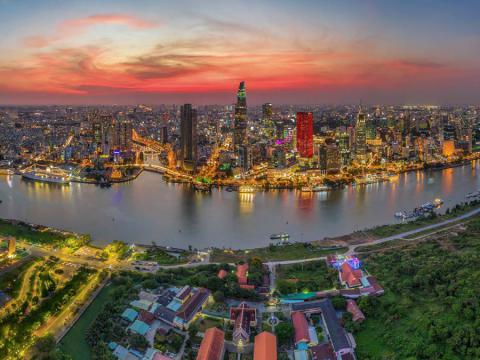Introducing Hanoi
Nestled along the banks of the Red River in Northern Vietnam, Hanoi stands as a living testament to the country's rich history, cultural diversity, and unwavering resilience. As the capital city and cultural heart of Vietnam, Hanoi's vibrant streets, ancient temples, and colonial architecture tell the tale of a city that has withstood the tests of time, from imperial dynasties to the struggles for independence. This essay explores the multifaceted essence of Hanoi, delving into its historical significance, cultural tapestry, and the indomitable spirit that defines this enchanting city.
Historical Tapestry:
Hanoi's history is a tapestry woven with threads of imperial rule, foreign occupation, and a relentless quest for independence. Its roots trace back to the founding of Thang Long, the city that would evolve into Hanoi, in 1010 during the Ly Dynasty. Over the centuries, Hanoi served as the political center of Vietnam under various dynasties, witnessing both prosperity and turmoil.
One of the city's most iconic symbols, the Temple of Literature, harkens back to the time of Confucius and the establishment of the country's first university in 1076. The temple, with its serene courtyards and ancient stone steles, reflects the intellectual and scholarly pursuits that have long been integral to Hanoi's identity.
The Old Quarter, with its narrow streets and traditional shophouses, preserves the architectural legacy of the city's mercantile past. Each street in this labyrinthine district carries the legacy of specialized trades, reflecting the guild-based organization established during the 15th century.
French colonial rule left an indelible mark on Hanoi, evident in the tree-lined boulevards, elegant villas, and the iconic Hanoi Opera House. The juxtaposition of colonial architecture with traditional Vietnamese structures creates a unique urban landscape that encapsulates the city's complex history.
Cultural Diversity:
Hanoi's cultural vibrancy is a harmonious blend of indigenous traditions and the influences of Chinese, French, and Southeast Asian cultures. The city's diverse population contributes to a rich tapestry of customs, cuisines, and celebrations.
The Water Puppet Theatre, a traditional Vietnamese art form dating back to the 11th century, epitomizes Hanoi's commitment to preserving its cultural heritage. Water puppetry, with its intricately carved wooden puppets, narrates tales of rural life, legends, and historical events, captivating audiences with its unique blend of puppetry, music, and water.
Hanoi's street food culture is legendary, with bustling markets and sidewalk stalls offering a gastronomic adventure. From the savory aroma of pho, a traditional Vietnamese noodle soup, to the sweet indulgence of banh mi, a French-inspired baguette sandwich, the city's culinary scene reflects the fusion of flavors that define Vietnamese cuisine.
The annual Tet Festival, celebrating the Lunar New Year, transforms Hanoi into a spectacle of color, music, and tradition. Streets adorned with peach blossoms and kumquat trees come alive with dragon dances, fireworks, and the exchange of traditional gifts, embodying the city's commitment to preserving its cultural rituals.
Resilience and Modernity:
Hanoi's history is not without its share of challenges, from foreign occupations to the ravages of war. The city's resilience, however, is evident in its ability to rise from the ashes and embrace modernity while safeguarding its cultural identity.
The Ho Chi Minh Mausoleum, a monumental structure housing the preserved body of the revered leader, stands as a symbol of the nation's resilience and the enduring spirit of the Vietnamese people. Surrounded by the vast expanse of Ba Dinh Square, the mausoleum is a focal point for both reflection on the past and aspirations for the future.
In the midst of rapid urbanization, Hanoi has embraced modernity without sacrificing its cultural authenticity. The skyline is dotted with skyscrapers and contemporary structures, while the city's ancient temples and pagodas stand as reminders of its storied past. The Long Bien Bridge, an iconic symbol of French engineering, continues to span the Red River, connecting the old and new quarters of the city.
Conclusion:
Hanoi, with its rich historical tapestry, cultural diversity, and unwavering resilience, emerges as a city that encapsulates the soul of Vietnam. From the ancient alleys of the Old Quarter to the modern skyline that reflects the nation's progress, Hanoi embodies a delicate balance between tradition and progress. As the capital, it not only serves as the political center of the country but also stands as a living testament to the endurance of a people who have weathered the storms of history while celebrating the beauty of their cultural heritage. Hanoi, with its indomitable spirit, invites visitors to explore its streets, savor its flavors, and immerse themselves in a city that whispers tales of the past and dreams of the future.
Last modified on 11/19/2023 - 05:15
Places 0
Currently there are no places in Hanoi.
Articles 0
Currently there are no articles about Hanoi.
Trip reports 0
Currently there are no trip reports about Hanoi.
Photos
Currently there are no photo of Hanoi.
Videos
Currently there are no videos of Hanoi.



